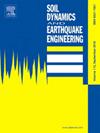Seismic response of utility tunnel system in horizontal nonhomogeneous site considering different structural forms
IF 4.2
2区 工程技术
Q1 ENGINEERING, GEOLOGICAL
引用次数: 0
Abstract
A utility tunnel is a type of long-lined underground structure that commonly crosses nonhomogeneous sites during construction. This study focuses on the seismic response of the utility tunnel system in horizontal nonhomogeneous site under transverse excitation, considering both the prefabricated utility tunnel system and the cast-in-place utility tunnel system. In the shaking table tests, the external structures were constructed using microconcrete, and internal pipes at different locations were considered. Numerical models were also built for the simulation. The relevant settings were consistent with the test conditions, and the results were in good agreement with the test results. Based on the numerical modeling results, the seismic response of the utility tunnel system in homogeneous site was obtained and carefully compared with that in nonhomogeneous site. The study results showed that the acceleration response of the prefabricated utility tunnel was generally more significant than that of the cast-in-place utility tunnel system and that there was variation in the longitudinal direction in the acceleration of the utility tunnel system in nonhomogeneous site. The maximum strain of the prefabricated utility tunnel structure was observed at the joint in nonhomogeneous site. By contrast, in homogeneous site, it was observed in the middle of the segment. The nonhomogeneous site also significantly influenced the earth pressure responses of the utility tunnel structures and the deformation of the joints in the prefabricated utility tunnel. This study provides a reference for the seismic design of the utility tunnel systems.
求助全文
约1分钟内获得全文
求助全文
来源期刊

Soil Dynamics and Earthquake Engineering
工程技术-地球科学综合
CiteScore
7.50
自引率
15.00%
发文量
446
审稿时长
8 months
期刊介绍:
The journal aims to encourage and enhance the role of mechanics and other disciplines as they relate to earthquake engineering by providing opportunities for the publication of the work of applied mathematicians, engineers and other applied scientists involved in solving problems closely related to the field of earthquake engineering and geotechnical earthquake engineering.
Emphasis is placed on new concepts and techniques, but case histories will also be published if they enhance the presentation and understanding of new technical concepts.
 求助内容:
求助内容: 应助结果提醒方式:
应助结果提醒方式:


